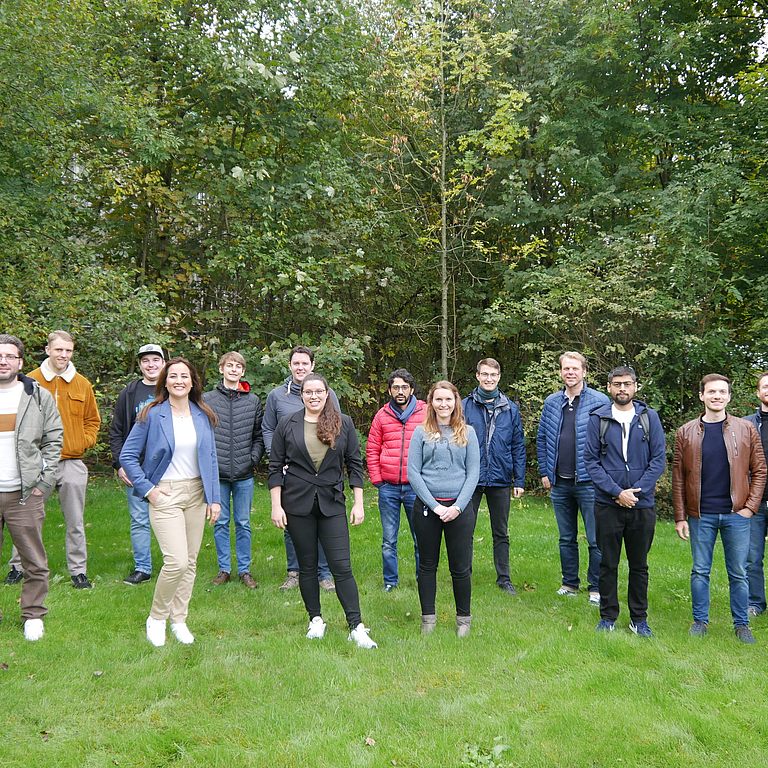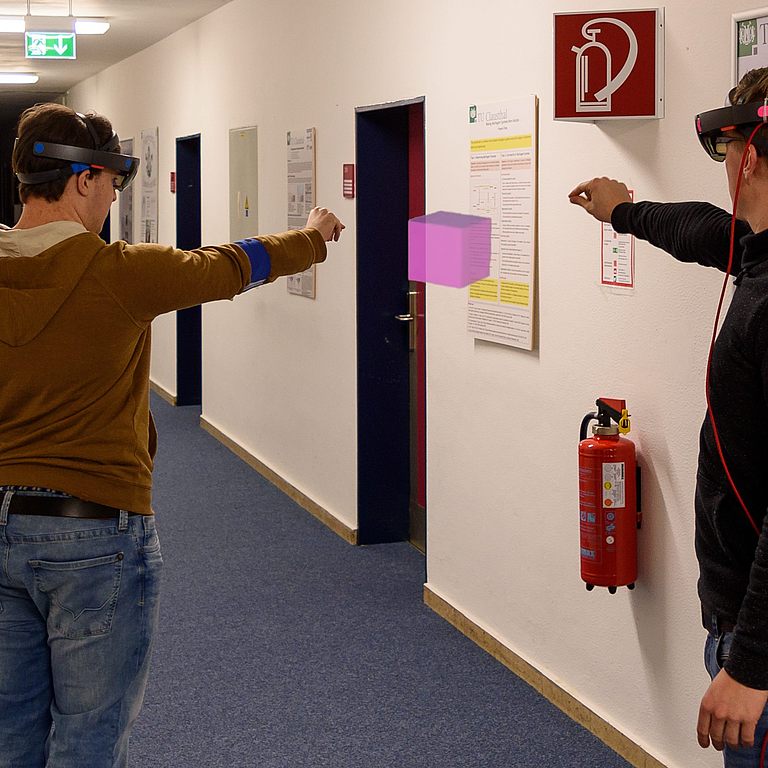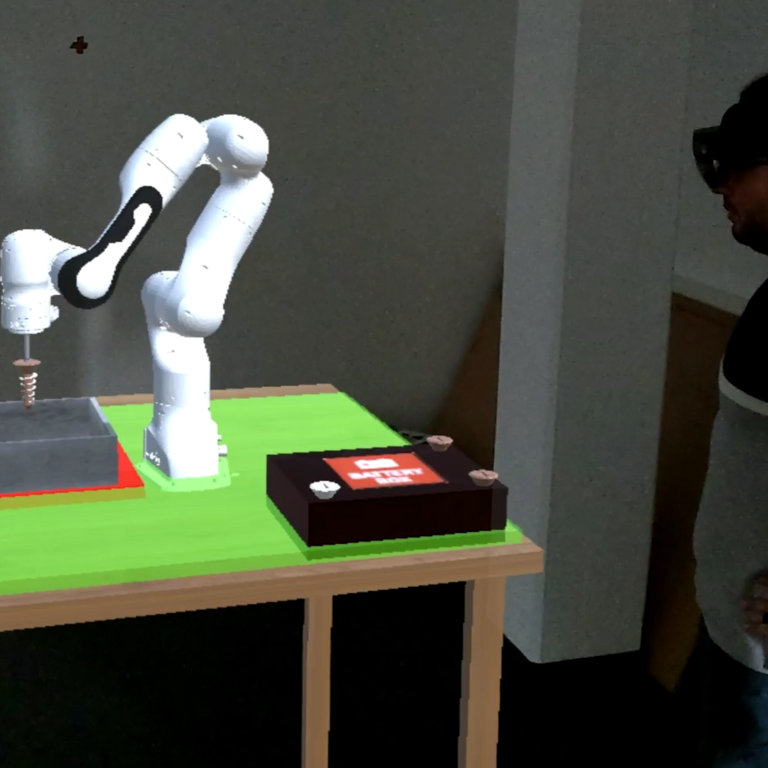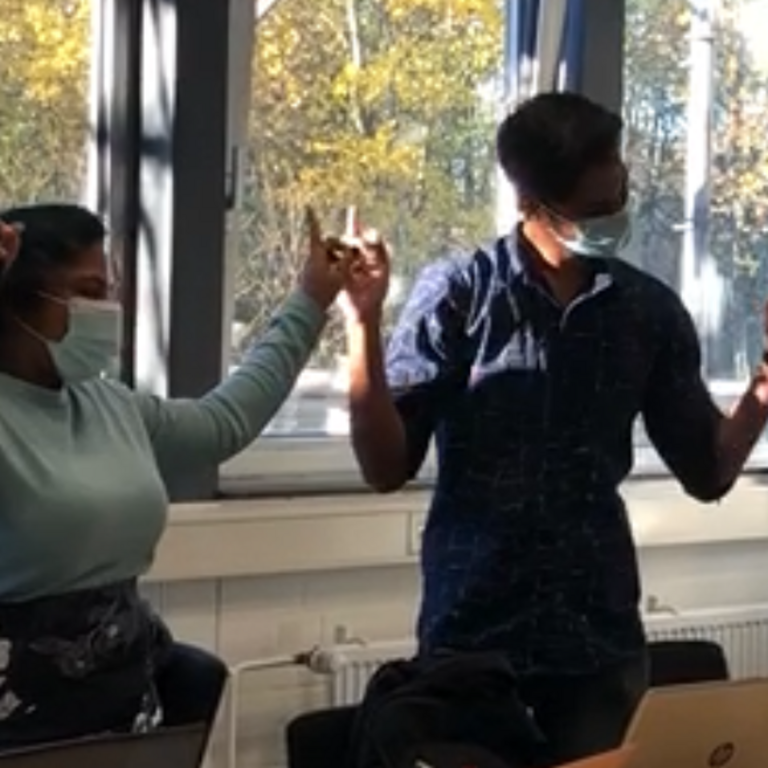Graduation Work
2020
Investigating the Role of Representing User Environments in AR Remote Consultations
As part of the ARBay project this research track evaluated AR based support for remote consultations. The study compared four different user environments for the remote helper, with a mix of Video, 2D/3D texturized models with a fixed and free perspectives. The video shows the setup and evaluation of the study.
Smartphone basierte Unterstützung bei der Ersteinrichtung von Augmented Reality Brillen
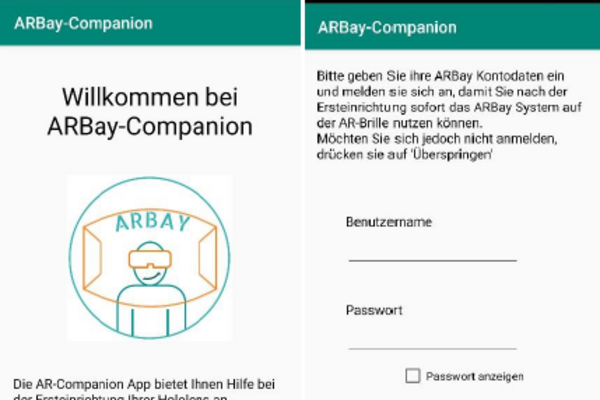
Im Rahmen dieser Arbeit wurde eine Anwendung entwickelt, welche das WLAN auf einer Datenbrille mit Hilfe eines Smartphones einrichtet. Damit Datenbrillen in Zukunft eine Erleichterung im Alltag ermöglichen können, muss eine einfache Einrichtung, insbesondere des Internets, gewährleistet sein. Dafür wird die bisherige Einrichtung analysiert und es werden Methodiken ermittelt, wie die Einrichtung erleichtert werden kann. Dazu wurde eine Anwendung entwickelt, über die sich das WLAN einer Datenbrille mit Hilfe eines Smartphones einrichten lässt. Außerdem wurde eine Möglichkeit implementiert sich direkt bei einem bestehenden System, wie zum Beispiel in dieser Arbeit dem ARBAY System, anzumelden. Anschließend wurde durch eine Evaluation ermittelt, inwiefern die Anwendung für zukünftige Zwecke verbessert werden kann
The Effects of Consultant Avatar Size and Dynamics on Customer Trust in Online Consultations
This thesis examines an online platform which is intended to enable customers to receive a consultation at home over the internet supported by augmented reality. For remote consultations of this kind, next to virtual furniture, displaying the consultant as virtual content to the customer as well might prove to be beneficial in some cases. This master’s thesis examines how the appearance of such a representation of the consultant, a 3D “avatar”, influences the trust towards the consultant perceived by the customer as well as their perceived social presence and overall satisfaction with the consultation. In addition, the same aspects are evaluated when comparing different movement dynamics of the avatar with each other. For the appearance comparison, this thesis compares life-sized avatars with miniaturized ones. The consultant avatar dynamics compare avatars that directly mimic camera movement inputs of the consultant by shifting their gaze direction and/or position within the customer’s living space with avatars that remain mostly static safe for always keeping eye contact with the customer, if possible.
2019
Pointing Modes and Frames of Reference for Remotely Supporting an Augmented Reality User in a Collaborative (Virtual) Environment
This research project was conducted as part of our project “ARBay” and was aimed at re-evaluating interaction mechanisms already known from previous research about remotely supported expert-worker scenarios, this time focusing on the context of remote consultations. A specially developed prototype was used to test different tools enabling a consultant using a PC to point at the environment of a remotely located customer wearing augmented reality glasses. Furthermore, different perspectives for placing virtual furniture in the environment of the customers were evaluated. The video shown here showcases one of the pointing methods and perspectives for placement, each.
2018
Displaying Context-Dependent Information in an AR Environment Exemplified by Virtual User Manuals and Presentations
This bachelor thesis is aimed at answering the question of how augmented reality-applications can expand or replace classical manuals and presentations. For this, a system was developed for the Microsoft HoloLens, which is capable of automatically recognizing 2D images/texts and 3D objects within the surroundings, is able to highlight them and to display additional content, such as descriptions or 3D models, next to them.
System zur Nachverfolgung der Haltbarkeitsdaten von Lebensmitteln und zur Vermeidung von Lebensmittelverschwendung
This bachelor thesis is about the conceptual design and prototyping of an Android App which supports users by tracking best before dates of groceries to minimize waste. For this purpose, different functionalities like barcode scanning of receipts and recipe suggestion to use up groceries were implemented.
Authentifizierungsverfahren und Zugriffsverwaltung von virtuellen Objekten für Augmented Reality
This master thesis is about authentication and authorization mechanisms in Augmented Reality. As part of the thesis two different methods of authentication were developed and tested for the Microsoft HoloLens:
Using the Circle-PIN-Method the user enters their PIN by moving their head and selecting individual digits of a circle in a specific order.
Using the Picture-Points-Method the user has to select predefined points in a picture to authenticate herself.
Furthermore, an authorization system was incorporated in the project, which manages visibility of objects and grants read and write accesses on a user basis. During development, the main focus was placed on conceptualizing a graphical user interface suitable for the Microsoft HoloLens.
rfläche
Darstellungsformen für technische Anleitungen in Augmented Reality
In this thesis, an Augmented-Reality application for the Microsoft HoloLens was developed which enables users to create and use virtual manuals for technical products. As an example, a manual for a XY-Plotter was created.
2017
Augmented Reality Lernszenarien im Pflegebereich
In this master's thesis, topic: Entwurf und Entwicklung von realitätsnahen Lernszenarien mittels Augmented Reality, the student Timo Kunzendorff developed an application for the Microsoft HoloLens to support learners in the field of nursing care. One aspect to accomplish this was the usage of marker detection to show detailed medical procedures in realistic contexts. The developed prototype is designed to add further scenarios in a simple and fast way.
Nutzung von 3D Tracking in Augmented Reality
The bachelor thesis of Timo Giese has the topic "Nutzung von 3D Tracking in Augmented Reality am Beispiel einer 3D Spur für Videotutorials". In his thesis he explores the possibility to enrich videos (e.g. how-to videos) with an additional 3D-Track on a Microsoft HoloLens to show objects of the video in real-time on the Microsoft HoloLens in order to let the viewer gain a better understanding of the objects discussed in the video. The Microsoft HoloLens shows a virtual representation of the object shown in the video in real time, and the object is in sync with the motions of the object in the video. So when the object is turned over in the video to explain and show a certain aspect of the object, the virtual object on the Microsoft HoloLens is turned over as well.
Augmented Reality Inhalte in sichtbaren Rahmen
In this bachelor's thesis, topic: Darstellung von AR-Inhalten in sichtbaren Rahmen, the student Arno Carstens analzyed how the Microsoft HoloLens can detect rectangles in rooms. The detection algorithm was created by the student. Using the results of this thesis, the application can be used to detect various items in the real world based on having frames to annotate them.
Augmented Reality kooperatives Zeichentool
The following work has been conducted within a bachelor's thesis by Niklas Osmers, topic: Entwicklung eines AR-basierten kooperativen Zeichentools zum Zeichnen auf Momentaufnahmen der Umgebung. The application was written for Microsoft HoloLens and enables users to (collaboratively) paint in an augmented space and to share their drawings. Using this applications users can make annotations or highlightings to interact with others. The application was tested within a user study in which pairs of participants were tasked to explain the central perspective with vanishing points to each other, using the application to draw highlights as augmentations of the real world.
